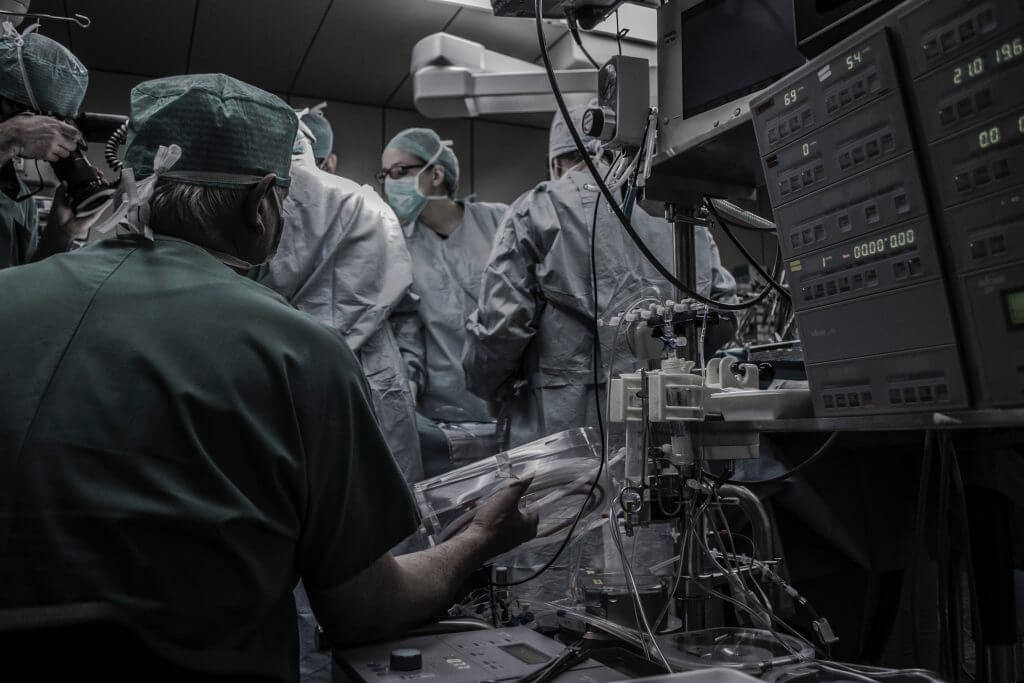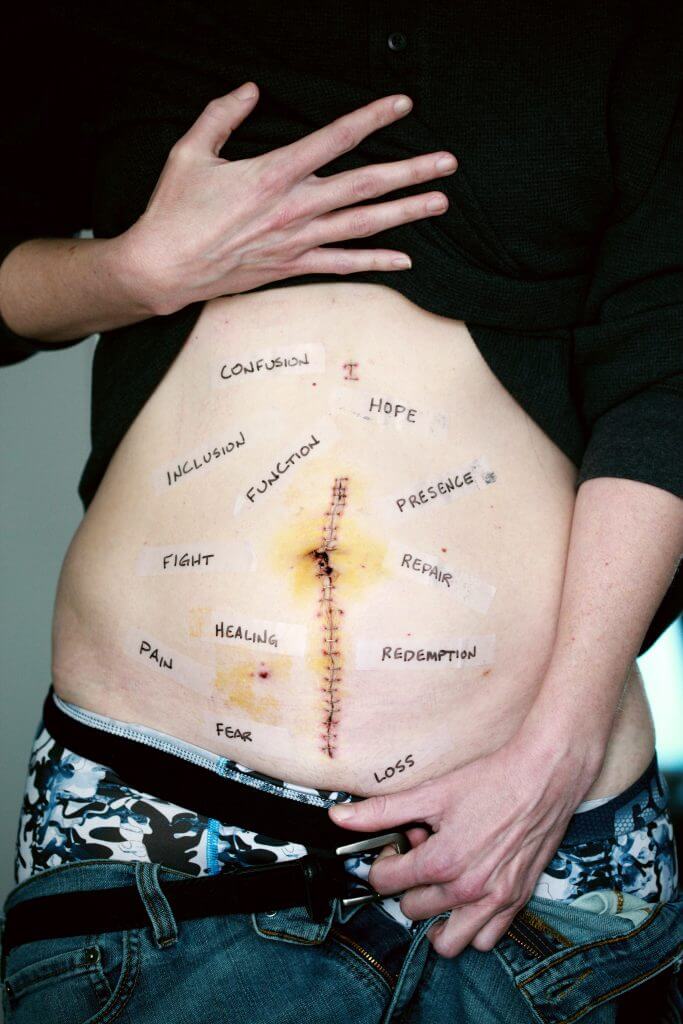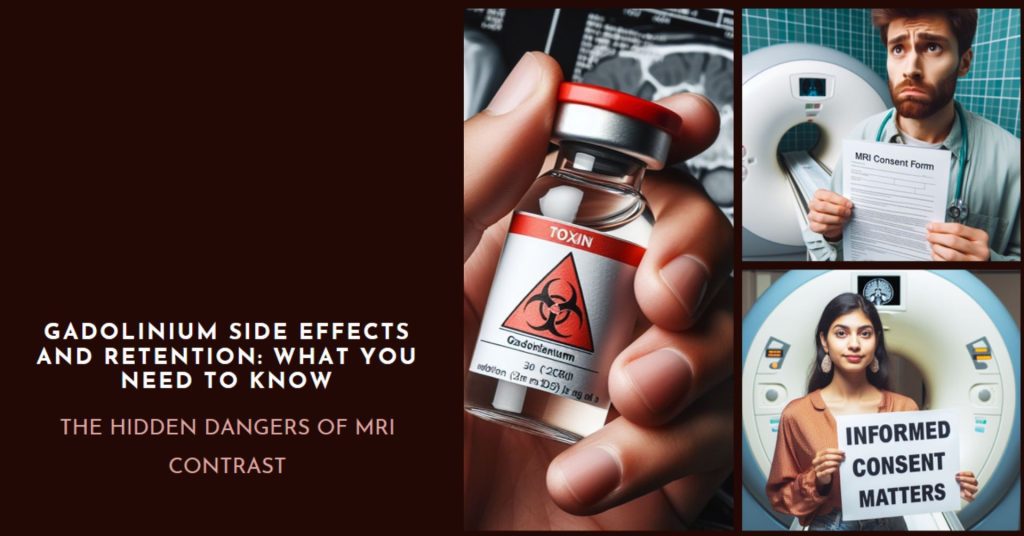Nobody told me gadolinium side effects could plague me for years after a single MRI gadolinium-based contrast
... or even cause permanent damage from the retention of gadolinium-based contrast agents!
Want to hear about the terrible mistake I made that left me with gadolinium deposition in tissues that's lingered for years?
Wednesday, 9th November 2016: That was the day my life changed. That was the day I had my first and only gadolinium-enhanced MRI scan. Gadolinium ruined my life. I will never have another one.
I sincerely hope that you’re reading this article to find out more about MRI contrasts before you decide whether or not to have one yourself or because someone precious to you has been offered one. But chances are that you’ve already suffered a medical injury caused by gadolinium deposition in tissues. If this is the case, please don’t despair. Even though it hurts now, better times are ahead.
If I’ve recovered from the retention of gadolinium-based contrast agents, so can you!
If you’re curious and would like to swap notes, I’ve written about my experience here.
In this article, I’ll cover:
- How informed consent for MRI contrast and most other medical procedures and drugs is a brilliant idea in theory, but in practice, it’s more fictitious than the tooth fairy,
- What gadolinium is and why you should care,
- Where gadolinium can deposit in your tissues,
- How gadolinium gets into your body in the first place,
- Whether it’s worth trying to look for long-term research on gadolinium toxicity symptoms in humans,
- What some of the symptoms of gadolinium contrast reactions are,
- And what might happen when you approach your doctor after suffering from gadolinium contrast agent reactions?
The Illusion of Informed Consent: The Dangers of MRI Contrasts and the Pharmaceutical Industry's Profit-Driven Agenda
The day of my MRI with contrast also led to my almost total loss of faith in the conventional medical system.
With hindsight, I now know the real reason my doctor ordered a scan using contrast. It wasn’t because it was necessary. It wasn’t. It was because a pharmaceutical cabal deals in misinformation and uncertainty. In this article, you can learn more about how the pharmaceutical industry profits by keeping you sick. And MRI contrasts are big money. Up to 2022, almost half a billion MRI contrasts had been injected into humans around the globe, each containing the toxic heavy metal gadolinium.
Professor Brent Wagner and his team said, “The commercialization of Gd use in imaging studies is outpacing the science addressing the long-term consequences of harboring this alien, toxic, nonphysiologic rare earth metal.”
Now that the blindfold has gone, and I can see Big pHARMa for what it is, I know I will only understand some of the implications of any medical decision if I research every single investigation and treatment offered to me. In short, I discovered that informed consent is just an illusion. You must understand this too for your own health and that of your family. You can’t provide informed consent if nobody tells you the risks of whatever they want you to do.
MRI Contrast and Informed Consent: What Your Doctor Isn't Telling You About Gadolinium toxicity symptoms after MRIs
Don't let a lack of informed consent put your health at risk. Learn the truth about gadolinium side effects and retention before your next MRI.

patients showed a profound lack of knowledge of GBCAs, including insufficient knowledge regarding possible adverse effects despite being a frequently prescribed diagnostic agent. Patients seemed to be poorly informed and could thus not make optimal decisions about their welfare.
The patients’ experience of neuroimaging of primary brain tumors: a cross-sectional survey study Tweet
When it comes to medical procedures, informed consent is crucial. It means that patients have the right to be fully informed about the benefits and risks of a procedure before deciding whether or not to undergo it. Unfortunately, many patients like us who receive MRI contrast dyes containing gadolinium are not given adequate information about the potential risks of contrast-enhanced MRI injections.
Gadolinium is a heavy metal that is used in MRI contrast dyes. The drug companies that market them claim they enhance the quality of the images. Your doctor has been told it’s safe and that, unless you have kidney disease, you’ll eliminate all the contrast within 48 hours if you drink plenty of water, leaving no long-term gadolinium deposition in tissues. However, there’s growing evidence that gadolinium can be retained in your body for months or even years after the MRI. This can lead to various symptoms, including pain, fatigue, cognitive impairment, and skin changes.
Despite these risks, many patients are not being informed about the potential for gadolinium retention. In the Netherlands, a survey of 100 patients with glioma brain tumours who had undergone MRIs with gadolinium-based contrast agents found that only 3% were aware of the risks associated with contrast-enhanced MRI injections. The authors commented that “patients showed a profound lack of knowledge of GBCAs, including insufficient knowledge regarding possible adverse effects despite being a frequently prescribed diagnostic agent. Patients seemed to be poorly informed and could thus not make optimal decisions about their welfare.”
The experience of patients in the Netherlands is in no way unique. Informed consent for MRI contrast is done shockingly poorly around the world. At least none of the clients and other people I’ve spoken with about gadolinium contrast agent reactions had received enough information about side effects to enable them to make informed decisions, let alone to provide written consent for MRI contrast. What’s the point in understanding MRI consent forms if one of the cardinal consent rules is omitted? Informed consent must be informed for it to be valid. The name should give it away.
The lack of informed consent around gadolinium-based contrast agents is a serious issue. Patients have the right to make informed decisions about their medical care, including being fully informed about a procedure’s potential risks and benefits. If you are considering an MRI with contrast, you must ask your doctor about the potential risks of gadolinium retention and any possible side effects. Be bold, ask questions, and advocate for yourself. Your health and well-being are worth it.
It's alarming to know that most doctors lack sufficient knowledge about the adverse effects of gadolinium contrasts
Doctors seldom have the knowledge to advise patients about the true risks and benefits of the treatments, surgeries, and investigations they offer. They don’t have the time to search the literature. Even if they did, they rarely have the skills to appraise those studies critically. Nor do they have access to unpublished data.
Often, most of the information on risks is hidden in unpublished studies. Doctors also usually can’t spot enormous gaps in research. This is critically important. As a result, industry-funded studies often market only the benefits and omit any harms of their product.
All that means is that you and your doctor only get a fraction of the whole story. The way that drug companies design and publish clinical trials conceals adverse health effects.
The blind leading the partially sighted
Awareness of gadolinium-based contrast agents (GBCAs) adverse health effects is growing. But at a crawl. When Sky News interviewed me about it back in 2018, and the Daily Mail interviewed me a year before, very few people had even heard of the element gadolinium, let alone knew it was used as the contrast for MRI scans. That has changed amongst patients now. But you might still discover about the retention of gadolinium-based contrast agents before your doctor does.
I’ve heard far too many stories about people not being believed by their doctors when they raise the issue of gadolinium toxicity after their MRI scans. Has your doctor listened to you when you voiced concerns about the adverse effects? I hope they have. But you might be in the minority if you have an understanding doctor who’s willing and able to help with gadolinium contrast agent reactions.
The Unspoken Risks associated with contrast-enhanced MRI injections: How Patients Are Being Left in the Dark About Gadolinium Side Effects and Retention

Let me tell you about gadolinium-based contrast agents so you can avoid finding yourself in a similar situation.
I now know many people who have had similar experiences as a result of having one or more gadolinium-enhanced MRI scans. In fact, despite being able to personally identify with all of the symptoms I describe below and more, I count myself luckier than most in the gadolinium toxicity groups. At least I’ve been improving. Many others are suffering from heart-breaking gradual deterioration for months or years because of gadolinium side effects. Some friends are no longer with us.
What is gadolinium?
Gadolinium is a rare earth element in the lanthanide group. Like the other elements, it’s a toxic heavy metal. In addition, it’s also the most potent calcium channel blocker ever identified. It is known to be poisonous to:
- mitochondria,
- cells,
- tissues, particularly connective tissue,
- liver,
- kidneys,
- and the nervous system.
Unfortunately, many studies now confirm gadolinium deposition in tissues. In humans, gadolinium accumulates in bone in particular. But it can also accumulate in:
- skin,
- brain,
- kidneys,
- liver,
- joints
- and other tissues and organs.
Gadolinium toxicity causes oxidative damage, inflammation, and cell death. Studies like this one where Omniscan promoted multiple myeloma cell and tumor growth indicate that it probably causes cells to become malignant. That means there’s a good chance it could lead to cancer.

How do you get exposed to gadolinium?
It’s rarely found in living organisms (like the food you eat), so your exposure should usually be minimal under normal circumstances.
However, gadolinium is used in the contrast agents injected into patients during MRI scans so GBCAs are the top source of exposure.
The contrast agents are drugs based on chelating agents, also not found in nature. A chelating agent is a drug that is capable of grabbing on to a metal and holding on to it.
Chelating agents can also come unattached from the metal they bind (in this case gadolinium) in several circumstances. Firstly, in the vial they are stored in. Secondly, in your body. Finally, in the environment after they have been passed out in your urine.
Free chelating agents are also biologically active. In fact they’re not inert. Some of the chelating agents, like the one that’s used in the contrast agent, Prohance, have been shown to cause brain toxicity as well. This even occurs when not bound to gadolinium.
DTPA, the basic parent molecule used for all gadolinium contrast agents, has been shown to deplete essential nutrients, including zinc and calcium. Due to safety concerns, DTPA is not licensed for use during pregnancy. This is even when it’s not bound to the toxic element, gadolinium.
What long term research has been done on people who have been injected with gadolinium based contrast agents?
Gadolinium based contrast agents are proven to cause an often fatal connective tissue disorder in the only group of people who have been studied long term: renal patients.
If you have normal renal function, you’ve probably been told not to worry. You only need to drink lots of fluids in the next few days and your kidneys will flush all the gadolinium contrast out in your urine within 4 days. Sound familiar?
The only problem is that this isn’t true. On 19th December 2017 in a drug safety communication, the FDA issued a new class warning about gadolinium retention, stating that all GBCAs for magnetic resonance imaging (MRI) leave gadolinium in the bodies, internal organs, and brains of all patients for months to years after a dose. It doesn’t matter whether your renal function is normal or reduced.
The commercialization of Gd use in imaging studies is outpacing the science addressing the long-term consequences of harboring this alien, toxic, nonphysiologic rare earth metal.
Professor Brent Wagner, et al Tweet
Patients with chronic kidney disease are the only ones who’ve been studied extensively to determine the actual long-term effects of gadolinium exposure. That’s how we know that gadolinium contrasts can cause horrifying adverse reactions. When patients with renal failure are injected with gadolinium contrast agents, they’re at increased risk of developing a devastating type of systemic fibrosis called nephrogenic systemic fibrosis (NSF) or gadolinium-associated systemic fibrosis (GASF).
So far, NSF (or, more accurately, GASF) has only been looked for in people with poor renal function following exposure to gadolinium. We need much more research on the short and long-term effects of gadolinium toxicity in humans. To date, researchers have been shy about looking for evidence of gadolinium toxicity symptoms after MRI.
By design, this will make it difficult for you to prove to your doctor that the symptoms you’re experiencing are caused by gadolinium deposition in tissues. Drug companies realize that if research proves MRI contrast agents aren’t as safe as they claim, doctors will stop prescribing these lucrative drugs and the companies may be liable to being sued by people who they have damaged. That’s a lose-lose situation that no for-profit company wishes to find itself in.
The downside is that in the absence of safety evidence, you can’t give informed consent for MRI contrast.
However, patient support groups and cohort studies of people with normal kidney function have identified constellations of symptoms. A growing number of people (both with and without chronic kidney disease) are starting to realise they’re suffering from these symptoms following gadolinium exposure.
What are some of the symptoms of gadolinium contrast side effects?
Here are just some of the gadolinium contrast agent reactions that people in gadolinium support groups complain of for months, and even years, after scans using GBCAs:
- Pain,
- brain fog,
- joint and muscle problems,
- metabolic syndrome,
- high blood pressure,
- fatigue,
- sleep problems,
- gut symptoms,
- skin disorders and
- other inflammatory conditions
- anxiety and depression
I’ve written about these and other adverse effects that people have described following gadolinium-based contrast injections in much more detail in my ebook, Contrasts: More than Meets the MRI. But I’ve also got a short, free downloadable guide for you which will answer many of your questions about the side effects of gadolinium contrasts for MRI. You can access the free guide immediately when you sign up for my newsletter. And there’s this article on gadolinium deposition disease as well.
Which gadolinium toxicity symptoms are most difficult to deal with?
Many people find the emotional burden, feelings of isolation, and psychiatric effects are some of the most challenging ramifications to cope with. Something that I hear over and over again from clients is that after they realise the magnitude of gadolinium toxicity symptoms after MRI, they feel like their life is over.
So, I wrote an article describing the mental torture of gadolinium contrast toxicity. Here’s another article about how sorrow can impact your physical health in ways you never imagined. In it, I explore the betrayal and hurt you experience when you feel betrayed by the system you’d placed your trust in to care for you when you’re sick and at your most vulnerable. The focus is on sorrow resulting from injuries caused by medical treatments and investigations like those resulting from gadolinium side effects.
We know that gadolinium contrast agents are inflammatory, mitochondrial toxic, calcium channel blocking drugs. So none of these symptoms should come as a surprise. They’re the commonest ways that inflammation, mitochondrial damage, and the blockade of calcium channels manifest.
You can also throw severe connective tissue damage into the mix since fibrosis is possibly the best-described symptom of gadolinium contrast agents. After all, that’s what nephrogenic systemic fibrosis is named after.
And what is atherosclerosis, if not hardening of the blood vessels? A hardening that is associated with both inflammation and connective tissue disorders. While high blood pressure is associated with abnormally stiff blood vessels. In fact, the blood vessels have lost their ability to respond properly to fluctuations in the blood supply to different tissues.
Acute and immediate complications of gadolinium-based agents are much better described in clinical studies. Unfortunately, they include death, shock, and organ failure.

What tends to happen when patients think that they are suffering from a chronic reaction to gadolinium?
Patients who present with symptoms are almost never investigated for gadolinium retention. Doctors seldom consider gadolinium toxicity! This is rather unsettling when you realise that when you were signing that written consent for MRI contrast, your doctor knew as much as you did about gadolinium toxicity and less than you know about it now that you’ve read this post! And it also poses challenges if you’re trying to discover who treats gadolinium poisoning.
Doctors are much more likely to order more gadolinium-enhanced scans to look for the cause of new symptoms and deterioration rather than consider whether their patients are suffering from adverse effects from the MRI. Then, patients suffer from worsening symptoms as a result. They may also undergo other investigations. Not only that, but they might end up misdiagnosed with conditions like amyotrophic lateral sclerosis (ALS – you might know it by a different name. It is also called Lou Gehrig’s Disease and Motor Neurone Disease), and be treated with powerful medications.
Can gadolinium get into the environment?
As yet no-one has fully elucidated the environmental effects of gadolinium contrast agents on aquatic life. Or on fields irrigated with water containing increasing levels of gadolinium pollutants . However, preliminary studies are extremely worrying.
Have you received a gadolinium contrast agent in an MRI?
Were you warned that there are no long-term safety studies on how it will affect you? Did your doctor warn you about the potential risks of administering gadolinium to your health? Or were you reassured about the safety of gadolinium?
Are you worried about the risks of transferring it to your offspring? (the children of pregnant women injected with gadolinium are more likely to be stillborn. Inflammatory skin and joint conditions are more common in surviving children).
Do you worry about cumulative toxin exposure from our environment? Or what about the effects on plants, animals, and fungi of combined toxin exposure from multiple sources? These could include wastewater from medical procedures.
Have you found yourself affected emotionally and psychologically by gadolinium? Know that you aren’t alone. And you’ll find this post fascinating. But this post tells you all you need to know about how to deal with anxiety, even if you are suffering from gadolinium toxicity.
If your health has been affected adversely following GBCAs and you’re interested in exploring whether the natural, gentle ways I’ve used to get my life back could work for you too, I’d love to chat with you. You can easily schedule a free clarity call over the internet. Just follow this link.
Or you can email me by clicking here. I’m also on Facebook as The Food Phoenix and you can find me in some of the gadolinium toxicity Facebook groups.
If you’re curious and would like to find out more about how I work with people 1-on-1, You can find that out here.
Share your own experiences of gadolinium contrast below.






